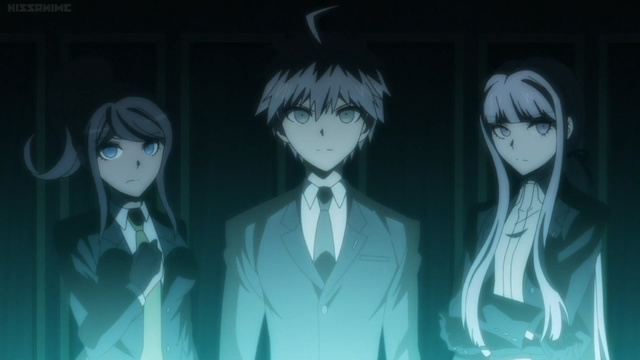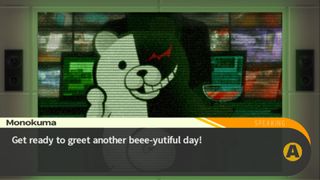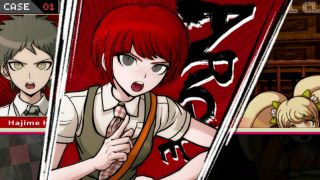Danganronpa outgrew gameplay and shifted to anime for its final act

When Spike Chunsoft announced Danganronpa 3: The End of Hope’s Peak Academy - the final act of a story that had spanned three games - would be an animated series, Danganronpa creator Kazutaka Kodaka told Famitsu (via Gematsu) he believed the story would be best concluded through an anime, rather than another video game.
The next game in the series, New Danganronpa V3, will bring back the Phoenix Wright-esque murder-mystery setting Danganronpa has become synonymous with, but will also focus on a brand new story and setting - one Spike Chunsoft says will be disconnected from the tale it began in Danganronpa: Trigger Happy Havoc.
Shifting mediums to tell a side story isn’t uncommon in the games industry. Developers of series such as Mass Effect, Uncharted, and Halo have used media like comics, novels, and films to show different sides of their respective universes. Even this year, Blizzard is using animated shorts and comics to expand upon Overwatch’s story almost exclusively, as the team-based shooter setup the game provides doesn’t support a lot of the tales that the company wants to tell. However, Spike Chunsoft’s decision to make the grand finale of Danganronpa’s story an anime is a bold move for the company, as it underlines a problem that video games often struggle with when it comes to unfolding their narrative compared to other mediums: gameplay can act as a restriction to narrative just as much as it can add to it.
For the uninitiated, the first Danganronpa game revolves around 15 high school students trapped in a school called Hope’s Peak Academy. This prestigious institution is for the best of the best, as everyone who attends is considered the “Ultimate” in their field. This means players will meet characters like the Ultimate Baseball Star, Ultimate Programmer, and the Ultimate Martial Artist. But as Makoto Naegi, the randomly-chosen Ultimate Lucky Student, players find their school life cut short as they and their classmates are locked within Hope’s Peak by an animatronic bear called Monokuma. This devious bear informs the group they will be forced to live within Hope’s Peak for the rest of their lives, cut off from the outside world. However, Monokuma gives these kids another option: kill one of your classmates and avoid being discovered by the survivors in a class trial, you’re free to go, leaving the rest of your classmates to be executed as you make your escape.

As Makoto, the player is forced to investigate several murders of their peers, and this means the moment-to-moment gameplay of Danganronpa is one part visual novel, another part point-and-click adventure, and a final part rhythm and puzzle-based class trials where they must use evidence they’ve gathered to unmask the killer.
Danganronpa’s premise is deceptively simple, but while the actual setup of Monokuma’s killing game seems rather straightforward, the events that led to it are far more elaborate, and are laid before the player in the first game’s final hours.
Outside the walls of Hope’s Peak Academy, Danganronpa’s world has been laid to ruin by an anarchy-driven group called Ultimate Despair. These people, under the charismatic influence of the game’s mastermind, have spread an ideology rooted in destruction and social unrest. While the movement began within Hope’s Peak Academy, the school was repurposed into a shelter in order to protect the remaining students, only to become a prison and stage for the killing game and Danganronpa’s many mysteries.
Sign up to the 12DOVE Newsletter
Weekly digests, tales from the communities you love, and more
The original murder-mystery setup that helped the first game be the success it was has become increasingly difficult to make possible in its setting without undermining the integrity of the story it’s trying to tell. Danganronpa 2: Goodbye Despair managed to recreate this scenario and make way for the gameplay that followed, but it had to stage its killing game on an island inside a virtual reality simulation to do it. The reasons for such a twist are explained in the context of the Hope’s Peak story, but it still had to separate itself from the reality of Danganronpa’s world in order to remake the same set up, so much so that it’s even questionable whether Danganronpa 2 takes place in the original game’s timeline for a fair amount of its run.

As a video game, a third Danganronpa visual novel would come bearing a great deal of expectation to be this same kind of murder mystery with recognizable investigation and puzzle mechanics. Players may go into it expecting a very specific gameplay mold, but it’s hard to imagine a way for the series to recreate this expected gameplay loop and still make it possible within the confines of the world it has established. Danganronpa 2’s ability to fit this template faced this same challenge, and while it made for compelling mysteries, it proved that recreating the same concepts within the original game’s world was an elaborate undertaking for Spike Chunsoft.
An animated series doesn’t carry these expectations; it merely has to wrap up loose ends and bring about a conclusion to the story that isn’t married to a particular story structure for the sake of gameplay. Interactivity can serve as a storytelling device that allows video games to tell stories other mediums can’t, but it also means a writer may be beholden to level design or mechanics. Ultimately, if Danganronpa’s story has exhausted its potential to manufacture the set up players want, what better way to conclude the story of Hope’s Peak Academy than with a medium that is under no obligation to entertain someone through interactivity?
This is why Danganronpa 3: The End of Hope’s Peak Academy exists in the animated form it does. Not only does it effectively bring closure to the story of Makoto and Hope’s Peak Academy, now that it’s complete New Danganronpa V3 is free to pick up the murder mystery with no restraints, as it can now create its own mysteries no longer trapped within the confines of what happened in Hope’s Peak Academy.
The interactivity of video games has helped the medium tell great stories that would have likely been fundamentally different without it, but it can also corner a writer into writing to create compelling gameplay rather than the story they may be looking to tell. By stepping out of the medium in its final act, Danganronpa found a way to severe its ties to the gameplay and story structure that helped it originally succeed, closing the doors of Hope’s Peak Academy in perhaps the most authentic and satisfying way possible.
Most Popular



